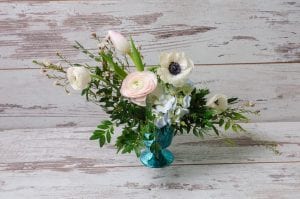A Guide to Sending Funeral Flowers
Although customs vary depending on the family’s religion or ethnicity, funeral arrangements of condolence flowers or basket gardens are often sent to the church, the funeral home, or the family’s home. (Notable exceptions are families of the Jewish faith. It has become somewhat more acceptable to send condolence flowers if the deceased was Jewish, but the Jewish faith does not generally express condolences with flowers.)
If the obituary specifically asks for donations to a charity in place of flowers, it is good etiquette to follow the family’s wishes.
When sending funeral flowers, be sure both your first and last names are on the card accompanying the flowers since the family may know several “Dawns” or “Jasons.”
Visit our Sympathy Flower Store to find an elegant bouquet to express your condolences.
Funeral Flowers — Selecting Appropriate Condolence Flowers
Traditionally, flowers are a way to represent growth, new life, and movement forward. The natural beauty of condolence flowers at a funeral and the mourners’ home brings a sense of warmth and comfort to the environment.
Today, flowers are not mandatory for funerals, but they are an appropriate way to express love for the deceased and concern for family members. Flowers can be ordered from a florist and delivered to the funeral home or residence.
Flowers for a funeral should arrive at the funeral home before the first visitation hours so the arrangement is there to greet the family when it arrives. If time does not permit delivery before visiting hours, you can send flowers or plants to the bereaved’s home. A potted plant has a conspicuous symbolic meaning because it will continue to live and grow.
Traditional Funeral Flower Arrangements
Flowers for funerals are generally categorized by their function. Here are a few of the more commonly used types of arrangements:
- Wreaths – These are circular floral arrangements that represent eternal life.
- Floral arrangements – There are many types of floral arrangements, from cut flowers to basket and container arrangements. See examples of Sympathy Flower Arrangements.
- Sprays – These are arrangements that allow viewing from one side only.
- Casket sprays – These are usually organized by the immediate family and sit on top of the casket.
- Inside pieces – These items, such as small floral sprays, are placed inside the casket.
Sometimes, Condolence Flowers are Not Appropriate
There are instances when flowers are inappropriate, such as when the family requests that donations be made instead of flowers. Many religions and cultures welcome flowers for mourning ceremonies. However, some do not traditionally receive flowers, such as the Jewish and Islamic faiths.
Jewish law has always demanded immediate burial – within three days – so condolence flowers weren’t necessary. It is still not customary to send flowers, although they are allowed. Some Jews have begun to send flowers for Reformed Jewish funerals. Instead of flowers, sending fruit and food baskets to the bereaved’s home during the mourning period is common.
At Islamic funerals, some people send flowers, and some do not. It is, however, common to place individual flowers on graves along with palm branches and other greenery. Flowers are not a traditional part of Hindu funerals, but they are not unwelcome.
At Buddhist funerals, white or yellow flowers are acceptable, but red flowers are not.
Refer to the Funeral Customs section for more information.
Choosing the Right Flowers
There are no particular types of flowers or colors that should be sent at funerals or homes of the bereaved. There are, of course, many favorites. Carnations, chrysanthemums, gladioli, lilies, and roses are popular choices for funeral flower arrangements. White lilies represent peace, and red roses are renowned for expressing love. If the deceased always loved being in the garden and had a favorite flower and color, it would be very comforting for the bereaved to receive an arrangement that includes these varieties.
Refer to the Flowers for Asian Funerals page for more details about appropriate flowers in Chinese cultures.
Shop our collection of Funeral Flowers to find the proper expression of your sympathy.
Particular types of flowers and their colors can send more specific messages. Here is a guide that will help determine if your choice of flowers is saying what you want it to say:
Apple Blossom:
Better Things to Come
Camelia:
Gratitude
Carnation:
Fascination/Love
Chrysanthemum (red):
I love you
Chrysanthemum (white):
Truth
Cyclamen:
Modesty/Shyness
Daffodil:
Regard
Daisy:
Innocence
Fern:
Fascination/Sincerity
Flowering Almonds:
Hope
Forget-me-nots:
True love/Remembrance
Heliotropes:
Devotion/Faithfulness
Honeysuckles:
Generosity
Hyacinths:
Loveliness
Hydrangea:
Boastfulness
Irises:
Warmth/Affectio
Ivy:
Eternal fidelity
Japonica:
Loveliness
Jasmine:
Amiability
Leaves:
Hope
Lemon Blossoms:
Fidelity
Lilacs (white):
Youthful Innocence
Lilies:
Majesty
Lilies (white):
Peace
Lilies of the Valley:
Return of Happiness
Magnolias:
Perseverance
Maidenhair:
Discretion
Mimosas:
Sensitivity
Orange Blossoms:
Purity/Virginity
Peach Blossoms:
Captive
Roses (red):
Love/Respect/Courage
Roses (white):
Innocence/"worthy of you"
Roses (red and white):
Unity
Roses (pink):
Grace/Gentility
Roses (deep pink):
Gratitude/Appreciation
Roses (light pink):
Admiration/Sympathy
Roses (yellow):
Joy/Gladness
Roses (coral or orange):
Enthusiasm/Desire
Roses (burgundy):
Unconscious beauty
Roses (red & yellow blends):
Jovial/Happy
Roses (pale colors):
Sociability/Friendship
Rosebuds:
Beauty/Youth/Pure
A Single Rose:
Simplicity
Hybrid Tea Roses:
"I'll remember you"
A Crown of Roses:
Reward/Virtue
Rosemary:
Rememberance
Snowdrop:
Hope
Sweet Pea:
Delicate Pleasures
Tulip:
Love
Veronica:
Fidelity
Violet:
Faithfulness


